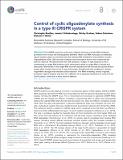Files in this item
Control of cyclic oligoadenylate synthesis in a type III CRISPR system
Item metadata
| dc.contributor.author | Rouillon, Christophe | |
| dc.contributor.author | Athukoralage, Januka S. | |
| dc.contributor.author | Graham, Shirley | |
| dc.contributor.author | Grüschow, Sabine | |
| dc.contributor.author | White, Malcolm F. | |
| dc.date.accessioned | 2018-07-20T16:30:05Z | |
| dc.date.available | 2018-07-20T16:30:05Z | |
| dc.date.issued | 2018-07-19 | |
| dc.identifier | 254021822 | |
| dc.identifier | 2f818a66-8898-43e6-8cb1-6574d52b3002 | |
| dc.identifier | 000439106900001 | |
| dc.identifier | 000439106900001 | |
| dc.identifier | 85052222007 | |
| dc.identifier.citation | Rouillon , C , Athukoralage , J S , Graham , S , Grüschow , S & White , M F 2018 , ' Control of cyclic oligoadenylate synthesis in a type III CRISPR system ' , eLife , vol. 7 , e36734 . https://doi.org/10.7554/eLife.36734 | en |
| dc.identifier.issn | 2050-084X | |
| dc.identifier.other | ORCID: /0000-0003-1543-9342/work/47136079 | |
| dc.identifier.other | ORCID: /0000-0002-1666-0180/work/60427712 | |
| dc.identifier.uri | https://hdl.handle.net/10023/15620 | |
| dc.description | This work was supported by a grant from the Biotechnology and Biological Sciences Research Council (REF: BB/M000400 /1 to MFW), and a Royal Society Challenge Grant (REF: CH160014 to MFW). | en |
| dc.description.abstract | The CRISPR system for prokaryotic adaptive immunity provides RNA-mediated protection from viruses and mobile genetic elements. When viral RNA transcripts are detected, type III systems adopt an activated state that licenses DNA interference and synthesis of cyclic oligoadenylate (cOA). cOA activates nucleases and transcription factors that orchestrate the antiviral response. We demonstrate that cOA synthesis is subject to tight temporal control, commencing on target RNA binding, and is deactivated rapidly as target RNA is cleaved and dissociates. Mismatches in the target RNA are well tolerated and still activate the cyclase domain, except when located close to the 3' end of the target. Phosphorothioate modification reduces target RNA cleavage and stimulates cOA production. The 'RNA shredding' activity originally ascribed to type III systems may thus be a reflection of an exquisite mechanism for control of the Cas10 subunit, rather than a direct antiviral defence. | |
| dc.format.extent | 22 | |
| dc.format.extent | 5943446 | |
| dc.language.iso | eng | |
| dc.relation.ispartof | eLife | en |
| dc.subject | QD Chemistry | en |
| dc.subject | QH301 Biology | en |
| dc.subject | Biochemistry, Genetics and Molecular Biology(all) | en |
| dc.subject | Immunology and Microbiology(all) | en |
| dc.subject | Neuroscience(all) | en |
| dc.subject | DAS | en |
| dc.subject | BDC | en |
| dc.subject | R2C | en |
| dc.subject.lcc | QD | en |
| dc.subject.lcc | QH301 | en |
| dc.title | Control of cyclic oligoadenylate synthesis in a type III CRISPR system | en |
| dc.type | Journal article | en |
| dc.contributor.sponsor | BBSRC | en |
| dc.contributor.sponsor | BBSRC | en |
| dc.contributor.sponsor | The Royal Society | en |
| dc.contributor.institution | University of St Andrews. School of Biology | en |
| dc.contributor.institution | University of St Andrews. Biomedical Sciences Research Complex | en |
| dc.identifier.doi | 10.7554/eLife.36734 | |
| dc.description.status | Peer reviewed | en |
| dc.identifier.grantnumber | BB/M021017/1 | en |
| dc.identifier.grantnumber | BB/M000400/1 | en |
| dc.identifier.grantnumber | CH160014 | en |
This item appears in the following Collection(s)
Items in the St Andrews Research Repository are protected by copyright, with all rights reserved, unless otherwise indicated.

